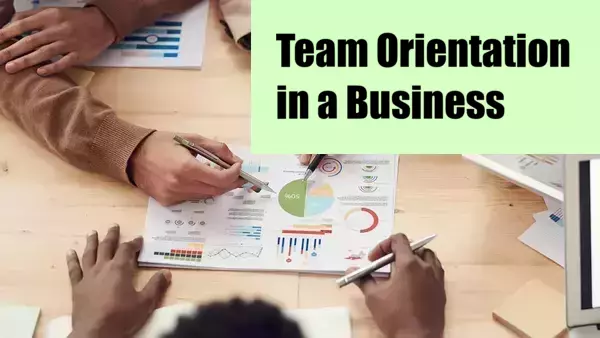In today’s dynamic and fast-paced world, there’s a phrase that we often hear buzzing around in corporate halls and networking events: “team-oriented”. It’s a quality that recruiters eagerly seek in potential employees, and leaders aspire to embody within their teams.
The emphasis on adopting a team-oriented mindset is evident everywhere. But what does being “team-oriented” really mean? Is it merely about collaborating with your colleagues, or does it delve deeper into the core values that make a cohesive unit capable of achieving greatness?
Put on your team jerseys and come along as we explore the essence of this catchphrase and why it’s more than just a buzzword in the world of business and beyond.
Benefits of a Team-Oriented Environment
A team-oriented environment fosters collaboration, communication, and a shared sense of responsibility among employees, leading to numerous benefits in the workplace.
First and foremost, teams that work cohesively tend to be more productive, as they can capitalize on each member’s strengths and expertise.
Additionally, a culture of teamwork can boost employee morale and job satisfaction, as individuals feel valued and recognized for their contributions.
In turn, this can lead to lower rates of employee turnover, saving companies resources in hiring and training new staff.
Finally, team-oriented environments encourage innovation, as employees with diverse perspectives can openly share ideas and work together on creative solutions to problems.
Elements of Team Orientation
- Diversity Awareness: Valuing diversity fosters creativity, adaptability, and innovative thinking within the team, enhancing the quality of problem-solving and idea generation processes.
- Open Dialogue: Encouraging open communication among team members facilitates better understanding, involvement, and collaboration, making employees feel valued and comfortable.
- Team Projects: Assigning tasks based on individual strengths and abilities fosters shared goals and increases overall team efficiency and success.
- Team-building Activities: Organizing team-building exercises promotes camaraderie, trust, and cooperation, strengthening the overall group dynamic.
- Knowledge Sharing: Encouraging employees to share their expertise cultivates teamwork, collaboration, and continued learning.
- Active Listening: Building relationships grounded in active listening leads to clearer communication, fewer misunderstandings, and increased productivity.
- Positive Attitudes: Fostering a positive work environment increases employee satisfaction, optimism, and commitment to the team’s efforts.
- Inclusive Leadership: Flattening the hierarchy and valuing collaboration over traditional top-down management styles promotes a more team-oriented approach, bolstering employee involvement and loyalty.
Diversity Awareness
Diversity awareness is a vital aspect of team-oriented businesses, as it encourages the appreciation and understanding of varying perspectives, cultures, and backgrounds among employees.
By valuing diversity, organizations can foster a more inclusive and collaborative environment, promoting creative problem-solving and innovative thinking. Focusing on diversity awareness can lead to better decision-making, increased employee satisfaction, and improved overall performance in the workplace. Investing in diversity training workshops and cultivating open communication channels can help employees recognize the unique strengths and talents of their colleagues, resulting in a more cohesive and supportive team.
Embracing diversity awareness ultimately leads to a more positive and productive work environment.
Fostering Open Dialogue
Embracing a culture of open dialogue means creating an environment where all team members feel comfortable sharing their ideas, opinions, and concerns without fear of judgment or retaliation. By encouraging open dialogue, organizations can promote innovation, increase employee engagement, and improve overall performance.
Factual data shows that teams with open communication channels are more likely to cooperate effectively and achieve shared goals. To foster open dialogue, leaders should ensure a respectful atmosphere, encourage active listening, and maintain a positive attitude.
Implementing Team Projects
Team projects are a fundamental aspect of fostering a team-oriented work environment. By assigning tasks based on each team member’s abilities and strengths, projects can be accomplished more efficiently and cohesively.
Moreover, implementing team projects helps employees understand how each individual’s contribution plays a vital role in achieving shared goals.
The collaborative nature of team projects encourages open dialogue, active listening, and knowledge sharing – all of which contribute to a positive and team-centered atmosphere. By adopting a team-oriented approach to projects, businesses can experience improved morale, increased productivity, and a richer sense of belonging among employees.
Team-Building Activities
Team-building activities are specially designed exercises and games aimed at fostering collaboration, trust, and effective communication within a team. These activities enhance teamwork and contribute to the overall success of a company, sports team, or any other group.
By participating in team-building exercises, members gain a better understanding of each other’s strengths and weaknesses, leading to improved problem-solving, decision-making, and goal achievement.
Examples of team-building activities include outdoor adventures, virtual reality games, or even cooking competitions. The positive impact of these exercises can greatly enhance employee/team satisfaction, workplace culture, and overall productivity, making team-building activities an essential investment for any organization.
Encouraging Knowledge Sharing
Organizations across the globe have recognized the value of creating a workplace culture that fosters knowledge sharing. This practice, which involves actively encouraging the exchange of information, ideas, and experiences among colleagues, has been found to significantly improve efficiency, innovation, and overall performance.
By implementing various tools and strategies, such as mentorship programs, collaborative platforms, and team workshops, employers can help facilitate a supportive and open environment where employees feel comfortable sharing their knowledge with one another.
This in turn leads to increased employee satisfaction, better decision-making, and a stronger collective intelligence within the organization, driving business success in the long run.
Active Listening
In today’s fast-paced work environment, effective team communication has become indispensable for success. One essential skill that fosters better team collaboration and understanding is active listening.
Active listening involves fully concentrating, comprehending, and responding thoughtfully to a speaker. It requires the listener to pay attention, avoid interruptions, and gather nuanced details that might not be openly shared. This valuable skill helps build trust, establish rapport, increase alignment, and reinforce respect among team members, ultimately leading to better decision-making and problem-solving.
By focusing on active listening, teams can bridge communication gaps and excel in their collaborative efforts, regardless of time zones or myriad forms of communication.
Characteristics of a Team-Oriented Leader
- Effective Communication: A team-oriented leader is skilled at conveying information and actively listening to others, ensuring everyone is on the same page.
- Empathy and Understanding: These leaders genuinely care about their team members’ well-being, making employees feel valued and appreciated.
- Encourages Collaboration: They foster a cooperative environment where everyone works together for the common goal.
- Adaptability: Team-oriented leaders can adjust their approach based on the changing needs of the team and organization.
- Delegates Tasks: They effectively delegate tasks, ensuring each team member’s strengths are utilized.
- Focuses on Personal Growth: These leaders understand the importance of individual growth for the team’s success and provide opportunities for development.
- Recognizes and Rewards Effort: They celebrate the accomplishments of their team members, motivating them to continue reaching for their goals.
- Resolves Conflicts: A team-oriented leader is skilled at diffusing conflicts and finding solutions that benefit the entire group.







